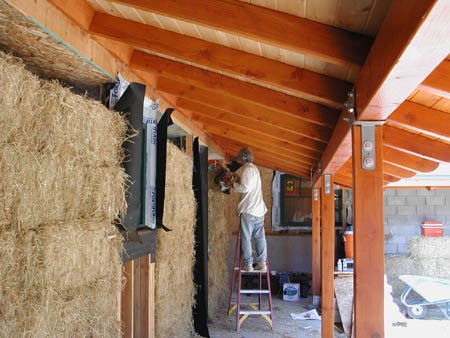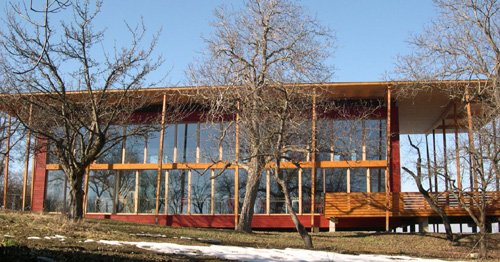Straw-bale construction
Straw bale construction is a housing design that is moving into the mainstream. Praised for sustainability and energy efficiency, straw bale homes deserve a second look.
As resources become increasingly scarce and energy efficiency becomes more of a concern, modern consumers are seeking alternatives to traditional housing design. Home owners and builders want to create sustainable homes that save energy without compromising architectural appeal. Straw bale construction, a 'new' technology that has been in use for nearly 100 years, seems to be an ideal solution. In addition to being aesthetically beautiful, straw bale houses are a sustainable, energy efficient housing design.

Straw Bale Construction Offers Energy Efficiency
Physical beauty aside, the most commonly touted advantage of straw bale construction is its energy efficiency. In laboratory conditions, an 18" straw bale has been shown to have an r value of 28 (RSI 5 in standard units,) roughly double that of a standard 2x6 fiberglass insulated wall. Additionally, the mass of straw and plaster in the walls creates a thermal sink that resists fluctuations in ambient temperatures. In theory, then, straw bale construction should offer significant energy savings over conventional housing design.
However, there has been relatively little good research done on the actual energy savings enjoyed by owners of straw bale houses. To answer growing demand, the Canadian Mortgage and Housing Corporation (CMHC) launched a study entitle Energy Use in Straw Bale Homes to compare energy efficiency of R2000 model homes to that of existing straw bale homes of the same dimensions. After adjusting for factors such as home appliances and hot water usage, the CMHC found that the straw bale houses included in the study use approximately 20% greater space heating energy efficiency compared to the tradtional houses.
Straw Bale Homes Resist Fires and Earthquakes
In addition to aesthetic appeal and energy efficiency, straw bale construction offers other structural advantages over conventional housing. The thermal mass that gives straw bale houses energy efficiency in heating and cooling also provides a strong yet ductile structure that resists damage during earthquakes and other natural disasters. Furthermore, the mass and density of the housing design is such that it resists ignition when exposed to flame, and is more likely to smolder than burn.
Drawbacks of Straw Bale Construction
One cannot speak of the virtues of a housing design without also exploring the drawbacks. The main concern expressed by potential straw bale home builders and CMHC alike is the possibility of mold growth, particularly Stachybotrys atra. While asthmatics and allergy sufferers usually report a lessening of symptoms in straw bale houses, care must be taken in humid climates to protect straw from dampness and mold.
Most long-standing straw bale homes have been constructed in the mid-western North America and parts of Australia where straw is plentiful and the climate is arid. When straw bale homes are constructed in the moister eastern regions of North America and northern Europe, dampness and mold become a potential health hazard. S. atra is a well-known indoor contaminant that seems to prefer straw over other substrates, and care must be taken during construction to prevent any dampness from entering the straw.

Making Sustainable Design a Priority
Henry David Thoreau said, "What is the good of having a nice house if you haven't got a decent planet to put it on?" With that sentiment, an increasing number of home builders are making sustainable housing design as much of a priority as curb appeal and affordability. With the right care and consideration, straw bale construction has the potential to offer all three.